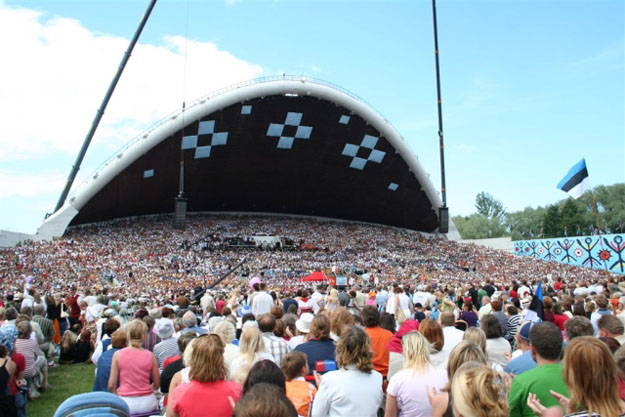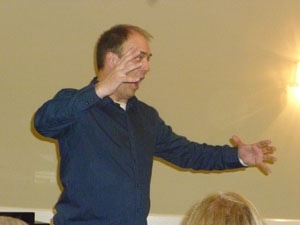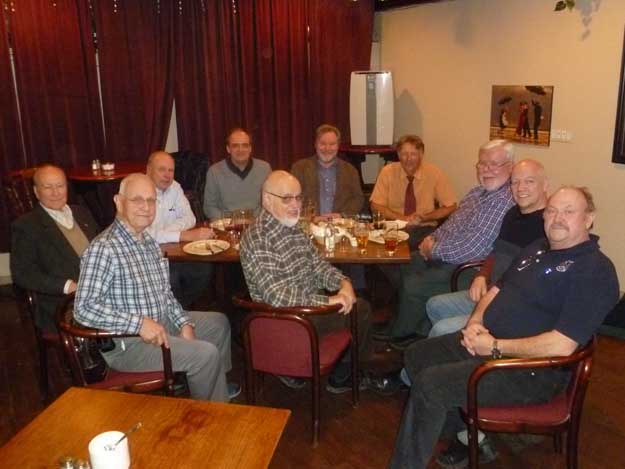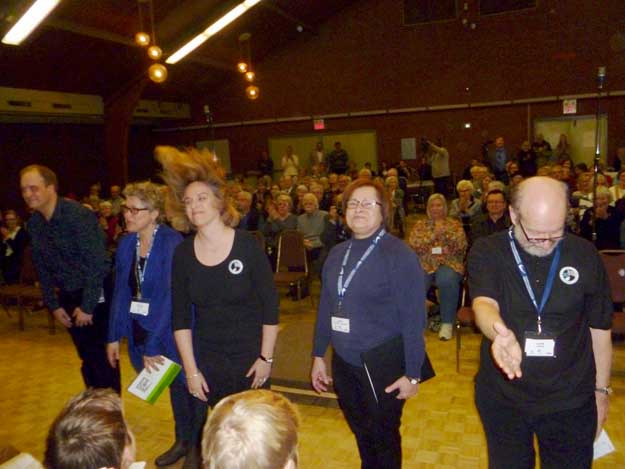 The finale of the Song Festival in 2004. I am on the stage’s 23th row, the 96th from the right; did you find me?
The finale of the Song Festival in 2004. I am on the stage’s 23th row, the 96th from the right; did you find me?
by Arved Plaks
Soon, this coming July, Estonia will burst into singing and dancing. Well, not every Estonian, but those not singing or dancing will be watching the procession of the participants to the festival grounds, clap for the performances or will be glued to their televisions. On July 5 and 6 will be the XXVI Song Festival and the XIX Dance Festival in Tallinn. A scientifically conducted nationwide survey the Estonians determined what people value the most. Of those who responded 86% rated the Song Festival as the nation’s most important event. The festivals are truly an expression of national unity and the celebration of the country’s culture.
The choirs or dance clubs which wish to participate have to rehearse hard and then compete for the honor to perform. There is limited space at the festival grounds for singers and only so much room at the dance field. If you want to participate most likely you are already rehearsing. If you want to see the performances and will be in Estonia in July, then it would be advisable to get your tickets early. Some events or seats have sold out in the past. The tickets are on sale now.
The Song Festival will take place on a stage 3 km east of the city in front of a gently sloping hill. The space has accommodated as many as two hundred thousand people. With the natural and augmented acoustic system the choirs and orchestral music can be heard everywhere on the field from the numbered near-stage seats to the unnumbered benches further away. Of course the people with poor eyesight might want the closer seats. The four Dance Fest performances are performed on an amphitheater close to the city center.
The reason why choirs have to compete for the privilege was explained recently by Mr. Hirvo Surva who visited Toronto to rehearse and evaluate the five choirs located in the Toronto – Hamilton area. Mr. Surva is the artistic director of the coming song festival. He said that 36000 singers have registered to sing at the festival but the capacity of the stage is only 25000 people. Thus selections must be made.
The competing choirs had to submit their taped performance and of those that were judged to be acceptable will have to perform “live” for the festival section directors to obtain the final approval. After that they have until July to polish their craft. The selection process is going on now.
 Mr. Surva spent a week in mid-January in Toronto. On weekday evenings he rehearsed and coached each of the Toronto and Hamilton choirs separately: The ‘Estonian School Choir’, ‘Ööbik’ (translated: nightingale), ‘Toronto Estonian Men’s choir’ (TEM), ‘Hamilton Estonian choir’, and choir ‘Estonia’. Each choir went through a very thorough process of honing the skill of singing and to capture the essence of the many songs in the festival song books. It was surprising how much emphasis Mr. Surva placed on bodily and mental “warm-up” exercises before a single song was rehearsed: how to produce voice, maintain posture, and breathe and so on. What a privilege it was to be instructed by one of the top choral conductors of Estonia. But no doubt all the while Mr. Surva was also evaluating our abilities.
Mr. Surva spent a week in mid-January in Toronto. On weekday evenings he rehearsed and coached each of the Toronto and Hamilton choirs separately: The ‘Estonian School Choir’, ‘Ööbik’ (translated: nightingale), ‘Toronto Estonian Men’s choir’ (TEM), ‘Hamilton Estonian choir’, and choir ‘Estonia’. Each choir went through a very thorough process of honing the skill of singing and to capture the essence of the many songs in the festival song books. It was surprising how much emphasis Mr. Surva placed on bodily and mental “warm-up” exercises before a single song was rehearsed: how to produce voice, maintain posture, and breathe and so on. What a privilege it was to be instructed by one of the top choral conductors of Estonia. But no doubt all the while Mr. Surva was also evaluating our abilities.
Before and between rehearsals was time to socialize at which Mr. Surva provided insight into the process of preparing for the coming event. The initial steps took place soon after the last festival in 2009. Various themes were proposed by potential directors of which one was Mr. Surva’s. It had occurred to him that while the Dance Festivals had had for themes forests and the sea; why not focus on people this time. Mr. Surva’s theme was selected and he was appointed to be the artistic director.
The theme led to the title “Aja puudutus, puudutuste aeg.” Loosely translated it means: “touched by the past, time of leave our own mark.” Mr. Hirvo explained that the first part means that with time the festivals have evolved, time has left marks and it is time to revisit them for continuity. The second part means that now it is time to leave our own footprint of the present day composers by which people may judge us in the future.
 Men of TEM taking a break: Alver Rõika, Arved Plaks, Indrek Uukkivi, (Choir elder), Hirvo Surva (artistic director of the Estonian song festival) , Mati Matsoo, Avo Kittask (Chairman of TEM), Allar Viinamäe, Charles Kipper (choir director), Ülo Isberg, and Urmas Migur. Photos by the author
Men of TEM taking a break: Alver Rõika, Arved Plaks, Indrek Uukkivi, (Choir elder), Hirvo Surva (artistic director of the Estonian song festival) , Mati Matsoo, Avo Kittask (Chairman of TEM), Allar Viinamäe, Charles Kipper (choir director), Ülo Isberg, and Urmas Migur. Photos by the author
There were many considerations in selecting songs. From the early song festivals songs with Estonian words, but German melodies were chosen as part of our legacy. To the credit to the directors of the first songfest in 1869, all songs were sung in Estonian. At that time Estonia was part of the czarist empire and the czarist hymn “God protect our Czar” had to be included in order to even hold the festival – but it was sung in the Estonian language! Mr. Hirvo assured us that this hymn would not be included in the current repertoire. For the first festival 27 songs were selected by April of that year and these were learned and were ready for the performance by the summer!
The first all-nation songfest was organized at the time of an awakening of Estonian culture. At the same time the national epic was written, the first Estonian language theater performed and the first Estonian language newspaper was founded. The awakening also had profound effect on the songs selected for subsequent festivals as increased native content was introduced. Other changes occurred as the scope and participation increased: to the initial all-male choirs female choirs were added and the composers found the soul of Estonia for their compositions.
The intervals between the festivals varied because wars and also because leadership dissention. Initially the location alternated between Tartu and Tallinn but now it is held every five years on the festival grounds of Tallinn. The festivals start with a parade of the participants: singers and dancers, from the city center to the festival site.
It should be added that the festival grounds has been the site of other gatherings such as youth song fests. The impromptu appearance of tens of thousands of protesters in 1988 was instrumental in congealing the spirit for independence. There too singing was a component.
While Estonia was occupied by the Soviet Union, participation by performers from the free world was not admitted. With the dissolution of the Soviet Union Estonians from the West have been welcomed. The writer was part of a combined but still small group of folk dancers from several countries who performed at the Kalev Stadium in 1990. The group was led by Thomas Metsala from Toronto. We danced to great applause. At the same time many choirs from the West were welcomed. Roman Toi and Taavo Virkhaus (from Alabama) were even asked to direct. And this brings us to today.
Mr. Surva wondered what should be presented to represent the current, should we include rock music? The decision was no, our youth must not to be underestimated. In the past youth has demanded songs like “Ta lendab mesipuu poole” the words capture the determination of bees to serve their hive regardless of obstacles. This is not a rock song.
Many of the songs that were chosen represented a bridge to the past, some to introduce new material. The material is in three sections, each has its own songbook: men’s-, mixed- and select choirs. In the repertoire are 37 songs not heard in the presented form before. Of these 14 are totally new songs by Estonian composers. While Estonian composers are trained in conservatories as expected, it may be significant that most came from villages and perhaps were less influenced by foreign trends, and consequently were closer our native heritage.
Mr. Surva gave also an overview of his concerns. Altough the total number of people wanting to sing is high; the number of men’s choirs has shrunk steadily. Because many men work outside the country is one reason. Would it not be shocking to observe that while men started the song festivals in 1869 but the women finish it? He also reminded us that while there were people who said that after achieving reindependence the purpose of the festivals has diminished, the indications are that they will continue well into the future.
 The choir directors thank the participants: Roosi Lindau, Ingrid Silm, Reet Voksepp, and Jaan Medri.
The choir directors thank the participants: Roosi Lindau, Ingrid Silm, Reet Voksepp, and Jaan Medri.
On the weekend following these individual choir rehearsals all choirs gathered at the Estonian House of Toronto for an intensive rehearsing. Thus all of the 200 singers contending to sing in Tallinn were now under the same roof. The participants included singers from Baltimore, New York and Michigan and Texas. It was called ‘LA LA LA singing camp’.
All day Saturday the choirs were rehearsed in sections by Mr. Surva and by the Toronto choir directors to follow up what had been learned in the preceding week’s rehearsals. The Estonian House Café kitchen under the direction of Ülle Veltmann provided breakfast and lunch with an Estonian touch.
The evening ended with a banquet at the Whistler, a nearby restaurant. The meal was followed by dancing, communal games and entertainment of the type that visiting Estonian choir director or folkdance groups bring with them: something in which all can participate. This tradition is sadly lacking in America culture.
The final day of the workshop, Sunday, like before, started with a breakfast buffet, warm-ups, singing by sections and lunch. In the afternoon followed a rehearsal with all singers in one unified choir as a preparation for the concert.
How is it that Estonians have taken to singing thusly? Perhaps when a country has big neighbors, one can rarely prevail with military means. But instead of defeatism it has decided as if it has found a common soul in intellectual expression to maintain a communal spirit. In the feudal times this spirit was supressed by foreign mercantile powers valuing Estonia’s geopolitical position on trade routes. When renaissances occurred in Europe, Russia loosened the grip of the feudal overlords. Slavery was rescinded, but due to forced russification the “Estonian true national spirit” – educational, political and cultural issues had to be expressed under the auspices of non-threatening cultural endeavors and thus literary societies, newspapers and local song festivals sprang up. One of the first occurred in Kambja, my ancestral village. Inevitably all-nation song festival was organized. And the rest is history!
The LA LA LA workshop ended on Sunday afternoon with a concert for the parents, spouses and friends of the singers. The hall was packed to capacity and the attendees got a taste of what awaits them in Tallinn. In attendance at the concert was maestro Roman Toi, the founder of choir ‘Estonia’. He led the choir to the Tallinn festival grounds in 1990, which was the first year that choirs from the west were allowed to participate in the festival. What sweet memories having been part of it!
For the concert the adult choirs cramped onto the stage and demonstrated what can be accomplished with intensive practice. Not only the traditional songs were sung but also songs not performed previously in Toronto. Then the children’s choir also joined the stage then the finale with 200 voices strong filled the hall with inspired music. The concert ended with the “Ta lendab mesipuu poole.” After Mr. Surva and the Toronto area choir directors thanked the singers for their hard work, Mr. Surva addressed the audience and thanked all for making him welcome. Then came the climax: he turned and as he looked at the 200 singers on the stage he announced: “you are all welcome to come to Tallinn and sing at the festival.” Hurrah! We had passed the test and are accepted! Thus all choirs had made the cut.
See ya’ll in Tallinn!















